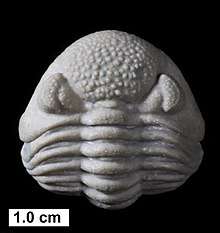Weis Earth Science Museum
Weis Earth Science Museum (abbreviated as WESM), located at 1478 Midway Rd, on the University of Wisconsin–Oshkosh, Fox Cities Campus in Menasha, Wisconsin, USA, was opened in 2002. It focuses on Wisconsin geology and its mining history. As such, it was designated as the Official Mineralogical Museum of Wisconsin by then-Governor Tommy Thompson in 2000, prior to its construction.[1]
 Weis Earth Science Museum | |
 Location of Weis Earth Science Museum  Weis Earth Science Museum (the United States) | |

| |
| Established | 2002 |
|---|---|
| Location | Menasha, Wisconsin |
| Coordinates | 44.231709°N 88.415879°W |
| Type | Earth science |
| Director | Dr. Joseph A. Frederickson |
| Nearest parking | On site |
| Website | uwosh |
Description and history
The museum is organized as theme galleries, interactive displays, and temporary exhibits, as well as research collections and office space. It holds some 10,000 specimens, of which about 1,000 are on display at any given time. Museum staff actively engages in public outreach through school tours. Plans are also being made for visiting schools and for creating digital, virtual fieldtrips. The collections, currently being cataloged in online databases, focus on the following themes as they pertain to Wisconsin and surrounding areas: Minerals, Fossils, Rocks, Sedimentary structures, Geology, Archaeology, Mining, Geologists, Geological sites, Mining history, and History of geological/archaeological studies.[2]
The galleries are currently laid out as: Space Rocks (meteors and meteorites), Introduction to the Earth, Wisconsin through Time, Wisconsin Industry, Water (Water Everywhere), The History of Animals featuring the Bruce Danz Collection, and the Barlow Gallery of Minerals.[2]
Curators and staff engage in a wide range of research topics in geology and paleontology, and they have written many scientific papers and books.[3][4][5][6][7][8][9] [10]
The WESM is named for Leonard and Donna Weis, who provided the founding financial gift to establish the museum and to endow the director’s position. Exhibits were designed by founding director Dr. Joanne Kluessendorf in conjunction with Derse Museum Group, Milwaukee. After the passing of Dr. Kluessendorf in 2018, Scott Mikulic was named interim director. In July of 2019, Dr. Joseph A. Frederickson was hired as the new permanent director. Dr. Donald G. Mikulic has been a volunteer curator since the WESM’s inception.[1][2]
Gallery
References
- Kluessendorf, Joanne; Mikulic, Donald G. (2 October 2004). Welcome to the 65th Annual Tri-State Geological Field Conference (DOC). 65th Annual Tri-State Geological Field Conference. Menasha, Wisconsin. pp. 2–3.
- <Not stated-->. "Weis Earth Science Museum". Weis Earth Science Museum. University of Wisconsin-Oshkosh. Retrieved 18 July 2020.
- Frederickson, Joseph; Engel, Michael H.; Cifelli, Richard L. (2018). "Niche partitioning in theropod dinosaurs: Diet and habitat preference in predators from the uppermost Cedar Mountain Formation (Utah, U.S.A.)". Scientific Reports. 8 (1). doi:10.1038/s41598-018-35689-6.
- Frederickson, Joseph; Schaeffer, Scott; Doucette-Frederickson, Janessa A. (2015). "A gigantic shark from the Lower Cretaceous Duck Creek Formation of Texas". PLoS ONE. 10 (6): e0127162. doi:10.1371/journal.pone.0127162.
- Gass, Kenneth C.; Kluessendorf, Joanne; Mikulic, Donald G.; Brett, Carlton E. (2019). Fossils of the Milwaukee Formation: A Diverse Middle Devonian Biota from Wisconsin, USA. Manchester, UK: Siri Scientific Press. ISBN 978-0-9957496-7-2.
- Kluessendorf, Joanne (2007). "Predictability of Silurian Fossil‐Konservat‐Lagerstatten in North America". Lethaia. 27 (4). doi:10.1111/j.1502-3931.1994.tb01584.x.
- Mikulic, D.G.; Briggs, D.E.G.; Kluessendorf, J. (1985). "A new exceptionally preserved biota from the Lower Silurian of Wisconsin, U.S.A." Philosophical Transactions of the Royal Society of London B. 311: 75–85. doi:10.1098/rstb.1985.0140.
- Mikulic, Donald G.; Landing, Ed; Kluessendorf, Joanne (2007). Fabulous fossils-300 years of worldwide research on trilobites. Albany: New York State Museum. ISBN 1-55557-235-9.
- Wendruff, A.J.; Babcock, L.E.; Kluessendorf, J.; Mikulic, D.G. (2020). "Paleobiology and Taphonomy of exceptionally preserved organisms from the Waukesha Biota (Silurian), Wisconsin, USA". Palaeogeography, Palaeoclimatology, Palaeoecology. 546. doi:10.1016/j.palaeo.2020.109631.
- Williams, David (8 May 2020). "Jurassic Park raptors may not have hunted in packs like they did in the movies". CNN. US. Retrieved 2020-07-17.


